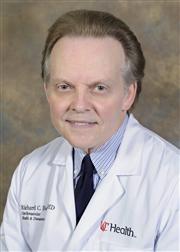Working to Change the Leading Cause of Death Throughout the World
Every year, approximately 10 million people worldwide, including 600,000 Americans, suffer from venous thromboembolism (VTE),1 and at least one in 12 middle-aged American adults will develop VTE in their remaining lifetime,2 says Richard C. Becker, MD. These statistics are part of the impetus for a national awareness effort—World Thrombosis Day (WTD), which is designed to raise awareness among clinicians and the lay community about thrombosis as the proximate cause of venous thromboembolism, heart attack and stroke.3 The drive is necessary, Dr. Becker says, because “VTE rates in the United States have not decreased in the past two to three decades. In fact, there has been an increase as the population ages.4 It is tempting to think that we, the scientific and medical communities, have ‘cured’ thrombosis; however, the humbling reality is that we have merely scratched the surface.” Dr. Becker, a cardiologist with University of Cincinnati Medical Center (UC Medical Center), director, University of Cincinnati (UC) Heart, Lung, and Vascular Institute, and director, division of cardiovascular health and diseases at UC, has long been involved in the study of thrombosis as a principal and co-principal investigator for clinical and translational investigations of thrombosis, hemostasis, vascular biology and pharmacogenetics. A much-published author, Dr. Becker is also the founding editor-in-chief of the Journal of Thrombosis and Thrombolysis.
According to Dr. Becker, “the most life-altering and life-threatening complication of VTE is acute pulmonary embolism, with three near- and long-term complications, including recurring VTE. Post-thrombotic syndrome, a condition with no known treatment, that causes pain, swelling and skin ulcers, can last for years after a first or second VTE. A final potential complication can be pulmonary hypertension due to recurring pulmonary embolism.”5
Physicians can improve their ability to diagnose VTE, says Dr. Becker. “Awareness of predisposing factors such as underlying cancer, pregnancy, oral contraceptives, hormone replacement therapy, inactivity particularly after surgery or injury, family history of VTE, smoking and obesity, as well as recognizing signs and symptoms of VTE, are key to early diagnosis and effective treatment,” he says. In considering a diagnosis of VTE, it is important to be aware of common signs and symptoms including pain, redness and swelling of the legs, and in less common cases, the arms.3
Dr. Becker points out that VTE is “more common among African Americans than other races.”6 The likelihood of death and complications from VTE is also higher in this population. Additionally, women have several unique risk factors for VTE.7, 8 These include pregnancy and the early post-partum period, the use of oral contraceptive agents or hormone replacement therapy and cancers involving breast, uterus and ovaries.
At UC Medical Center, care providers are committed to raising thrombosis awareness within the pre- and post- hospital environment as well as bringing awareness to the Tri-State region. Dr. Becker said that “systems of care” to properly prevent, diagnose and treat VTE and atrial fibrillation (AFib) – an objective in the 2016 WTD Impact Report – are operational at UC Medical Center. “Optimal patient care is the result of knowledge, expertise and resource availability. In the case of common conditions and diseases such as AFib and VTE, we have developed awareness and prevention strategies that can be applied broadly across the system of care according to specific patient needs. We also have established clinical programs specific to AFib and VTE which include physicians, nurses and advanced practice providers who are trained in these areas and are highly skilled in the diagnosis and on-going safe and effective management of patients with VTE and AFib.” Dr. Becker stresses that “thrombosis is seen in all areas of medicine. It is, in many instances, preventable, diagnosable and readily treatable.”
Hear from a UC Medical Center patient about her struggles with VTE.
For more information about World Thrombosis Day, see worldthrombosisday.org.
References
1. Jha AK, Larizgoitia I, Audera-Lopez C, et al. The global burden of unsafe medical care: analytic modeling of observational studies. BMJ Qual Saf. 2013;22;809-815.
2. Bell EJ, Lutsey PL, Basu S, et al. Lifetime risk of venous thromboembolism in two cohort studies. Am J Med. 2016;129,139:e19-339.e26.
3. World Thrombosis Day. worldthrombosisday.org. Accessed February 12, 2017.
4. Healthcare-associated venous thromboembolism. Centers for Disease Control and Prevention.
https://www.cdc.gov/ncbddd/dvt/ha-vte.html. Accessed February 11, 2017.
5. Fanikos J, Piazza G, Zayaruzny M, Goldhaber SZ. Long-term complications of medical patients with hospital-acquired venous thromboembolism. Thromb Haemost. 2009;102:688-693.
6. Key NS, Reiner AP. Genetic basis of ethnic disparities in VTE risk. Blood. 2016;127:1844-1845.
7. ESHRE Capri Workshop Group. Venous thromboembolism in women: a specific reproductive health risk. Hum Reprod Update. 2013;19:471-482.
8. Lee AYY, Levine MN. Venous thromboembolism and cancer: risks and outcomes. Circulation. 2003;107(23 suppl 1):117-121.
Suggested Readings
Wisler JW, Becker RC. Emerging paradigms in arterial thrombosis. J Thromb Thrombolysis. 2014;37:4-11.
Sherwood MW, Cyr DD, Jones, WS, Becker RC, et al. Use of dual antiplatelet therapy and patient outcomes in those undergoing percutaneous coronary intervention: The ROCKET AF Trial. JACC Cardiovasc, Interv. 2016;9(16):1694-1702.
Ruff CT, Ansell JE, Becker RC, et al. North American Thrombosis Forum, AF action initiative consensus document. Am J Med. 2016;129(suppl 5):S1-S29.
Muntner P, Becker RC, Calhoun D, et al. Introduction to the American Heart Association’s hypertension strategically focused research network. Hypertension. 2016;67:674-680.
Richard C. Becker, MD
Professor of Medicine
Director, Division of Cardiovascular Health and Diseases
Director, University of Cincinnati Heart, Lung & Vascular Institute
PHONE: (513) 475-8521
E-MAIL: richard.becker@uc.edu
Connect with Dr. Becker on Doximity
Leave a reply →

